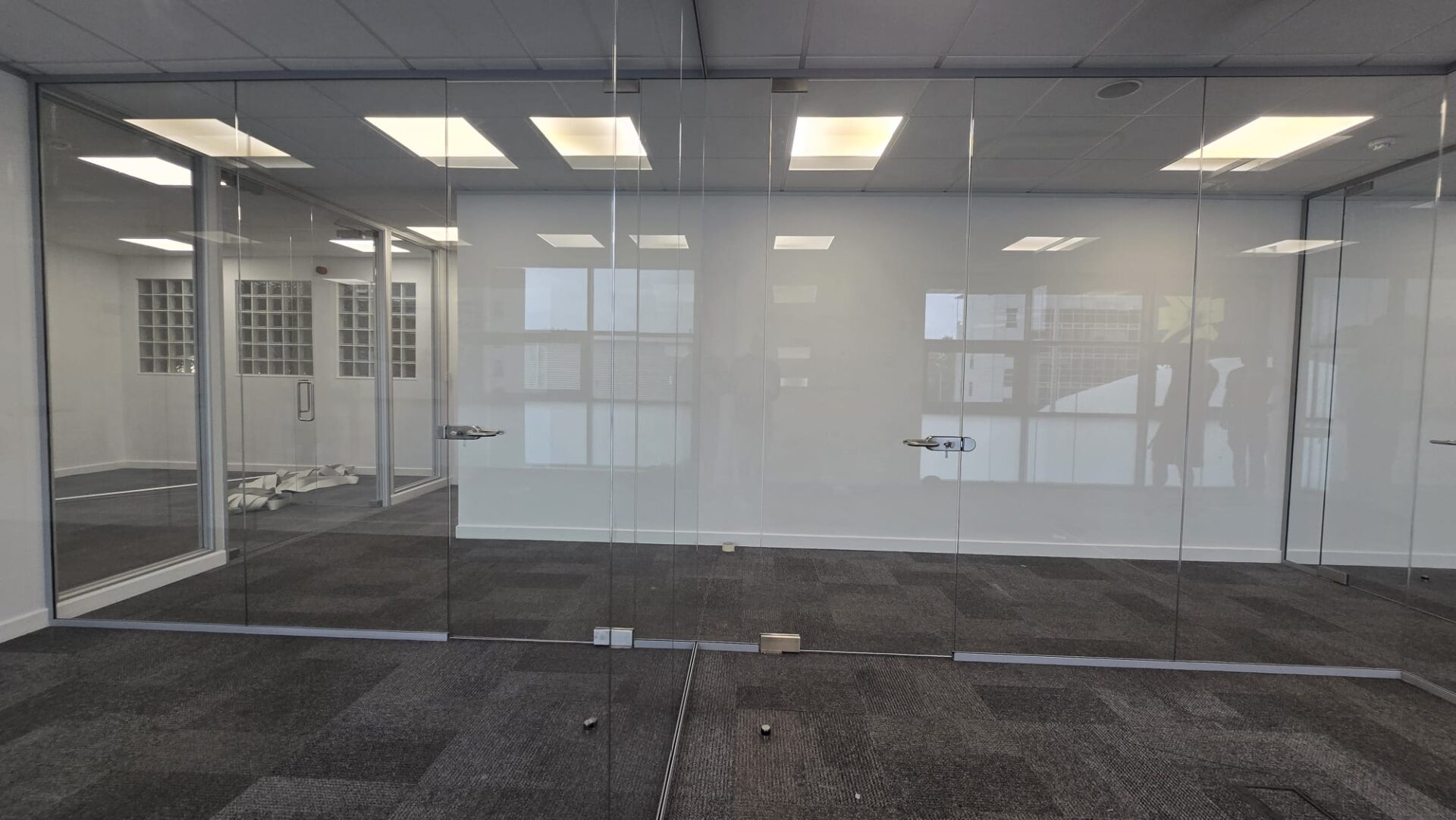
Tempered glass has become the go-to choice for modern interiors, from office partitions and glass doors to shopfronts and balustrades. It’s known for its strength, clarity and ability to withstand daily impact, but one question often sparks curiosity among designers, facility managers and business owners alike: does tempered glass break?
In this guide, you’ll learn how tempered glass is made, what causes it to shatter, the science behind its unique break pattern, when replacement is necessary, and practical ways to prevent glass failure in commercial spaces.
What is a Tempered Glass?
Tempered glass is a type of safety glass engineered to be significantly stronger and safer than standard or annealed glass. It’s created through a controlled heating and rapid cooling process that alters the glass’s internal structure. This process introduces surface compression and internal tension, making the glass up to four to five times stronger than regular glass of the same thickness.
Does a Tempered Glass Break?
Yes, tempered glass can break but it’s designed to do so in a controlled and safe way. While it’s much stronger than regular glass, it’s not completely unbreakable. The unique tempering process gives it impressive resistance to impact, pressure, and heat, but when that strength threshold is exceeded or the glass is compromised at a weak point, it can shatter suddenly.
How Tempered Glass Breaks?
1. Edge damage and installation defects
The edges of tempered glass are its most vulnerable points. A small chip or crack during transport or installation can compromise the internal tension, leading to sudden shattering, sometimes days or weeks later. Proper handling, cushioning, and avoiding direct metal-to-glass contact are crucial for preventing edge stress.
2. Direct impact beyond design load
Tempered glass is built to withstand strong impacts, but every glass panel has a design limit. A sharp or concentrated hit, especially with a hard object, can exceed that threshold and trigger breakage. This is more common in areas like office doors or balustrades where accidental knocks occur.
3. Thermal stress
Large temperature differences across a glass surface can create uneven expansion, leading to breakage. For instance, when one part of a glass façade is exposed to direct sunlight and another is shaded, internal tension increases. Using heat-soaked or thermally toughened glass helps reduce this risk.
4. Nickel Sulfide (NiS) inclusions and spontaneous breakage
Occasionally, microscopic nickel sulfide particles inside the glass expand over time, creating internal pressure that leads to spontaneous breakage, even without any visible damage. This is rare but possible in tempered glass. Reputable manufacturers use heat-soak testing to identify and eliminate panels prone to this defect.
5. Manufacturing defects or poor-quality material
Low-quality raw materials, uneven heating, or improper cooling during production can leave residual stress in the glass, making it prone to unexpected failure. Choosing certified glass that meets BS EN 12150 standards ensures safety and consistency in performance.
6. Excessive point loads from fixings or hardware
Improperly fitted clamps, hinges, or brackets can place localised stress on a glass panel, especially near its corners or edges. Over time, these point loads weaken the glass and may cause sudden shattering. Using rubber gaskets, correct torque settings, and professional installation can prevent this issue entirely.
What Happens When Tempered Glass Breaks?
When tempered glass breaks, it doesn’t form sharp, jagged shards like ordinary glass. Instead, it shatters into thousands of small, blunt-edged cubes. This controlled breakage pattern is one of its most important safety features, dramatically reducing the risk of serious cuts or injuries.
Is Shattered Tempered Glass Safe in Commercial Settings?
Yes, when tempered glass breaks, it is generally safe for occupants and workers nearby. This is why it’s widely used in commercial partitions, glass doors, and balustrades where public safety is a top concern.
That said, “safe” doesn’t mean risk-free. Even small fragments can cause minor cuts or create slip hazards if not cleaned up quickly. Additionally, a shattered panel compromises the structure’s integrity, making immediate replacement essential. Businesses are encouraged to follow UK building regulations, which require tempered or laminated safety glass in public and commercial spaces.
Immediate Steps After Tempered Glass Breaks
1. Secure the area immediately: Prevent access to the affected space to avoid injuries or contamination from glass particles.
2. Inspect surrounding panels and frames: If one panel breaks, check nearby glass installations for cracks or stress points.
3. Document the incident: Take clear photos and notes of environmental conditions; this helps identify causes such as thermal stress or improper fitting.
4. Contact a professional glazier: They’ll safely remove remaining fragments, assess frame integrity, and recommend a suitable replacement option.
5. Clean and vacuum the area thoroughly: Even small glass cubes can embed in flooring or furniture, so a detailed clean-up is vital.
Can Shattered Tempered Glass Be Repaired?
Unfortunately, once tempered glass breaks, it cannot be repaired or restored. Unlike laminated glass, which can sometimes hold its form after impact, tempered glass completely loses its structural integrity upon shattering.
The only solution is full replacement. Attempting to glue or patch broken sections not only fails aesthetically but also poses serious safety hazards. However, the replacement process is straightforward; modern glaziers can measure, cut, and install new panels quickly.
For long-term reliability, it’s wise to have regular inspections, use protective films or coatings where applicable, and choose high-quality, certified tempered glass that meets UK and EU safety standards.
Choosing Safer Alternatives or Enhancements for Commercial Projects
While tempered glass offers strength and safety, some commercial environments demand even higher protection or performance. Depending on project goals, several glass solutions can be used as alternatives or upgrades.
1. Laminated glass
Laminated glass consists of two or more glass sheets bonded with an interlayer, typically PVB or EVA. When broken, the interlayer holds the shards in place, preventing collapse and maintaining visibility until replacement. This makes it ideal for high-traffic areas, storefronts, or locations requiring added security and acoustic control. It’s also the safer option where fall protection or impact resistance is critical.
2. Insulated glazed units (double-glazed) with laminated inner pane
For projects balancing energy performance with safety, insulated glass units (IGUs) with a laminated inner pane are a smart choice. These double-glazed panels offer superior thermal insulation, helping reduce heating and cooling costs, while the laminated layer provides impact resistance and added soundproofing. They are particularly suited to modern office buildings and commercial facades seeking comfort, safety, and efficiency in one solution.
3. Toughened with laminated hybrid
This hybrid glass type combines the strength of heat-treated glass with the safety of lamination. Even if the outer toughened layer breaks, the laminated core holds the structure together, minimising risk and maintaining the barrier. It’s an excellent choice for high-rise buildings, balustrades, and glass canopies, any environment where durability, safety, and compliance are non-negotiable.
Installation, Inspection & Maintenance – Reducing Breakage Risk
Even the strongest tempered glass can fail prematurely if not installed or maintained correctly. Proper handling, professional installation, and ongoing inspections are key to minimising the risk of breakage in commercial settings.
During installation, we ensure that all glass edges, the most vulnerable part of any tempered panel, remain free from contact with hard surfaces or metal fittings. Using approved gaskets, seals, and fixings to distribute pressure evenly and avoid point loads that can trigger stress fractures over time.
Regular inspections are equally important. Look for early warning signs such as edge chips, surface scratches, or shifting hardware, all of which can compromise integrity. In environments exposed to heat or sunlight, periodic checks for thermal stress are essential. Finally, routine cleaning with non-abrasive materials helps preserve surface strength and visibility, ensuring both performance and presentation remain intact.
Cost & Replacement Considerations
When tempered glass breaks, it typically shatters completely, which means repair isn’t an option. Replacement costs vary depending on the glass type, thickness, finish, and site access. While standard tempered panels are relatively easy to replace, custom partitions, oversized panels, or glass with specialised coatings can increase both material and installation costs.
For commercial projects, it’s best to factor in long-term maintenance and replacement costs from the start by investing in high-quality glass and professional installation to reduce future risk and downtime. If you’re planning a new fit out or replacing existing glass, reach out to our team with your project brief. We’ll provide a tailored quote that aligns with your space, safety requirements, and design goals.
Final Thoughts
Tempered glass remains one of the safest and most trusted materials in modern architecture balancing strength, safety, and clarity. While it can break under certain conditions, understanding how and why it happens helps you make smarter decisions for your commercial space. With proper installation, inspection, and maintenance, tempered glass delivers long-term performance. Whether you’re designing an office, showroom, or retail environment, choosing the right glass type ensures both aesthetic appeal and safety compliance.
FAQs
No, tempered glass breaks into small, relatively blunt fragments rather than long, sharp shards common to annealed glass.
Spontaneous breakage due to NiS inclusions is rare — industry estimates vary, but modern quality controls have reduced incidence significantly. Still, some panels may fail after months or years.
Yes — while less likely to cause deep lacerations, the fragments can still cut. Use PPE and vacuums designed for sharp debris; avoid bare feet.
No. Once tempered glass fractures, it loses structural integrity and must be replaced rather than repaired or reglued.













